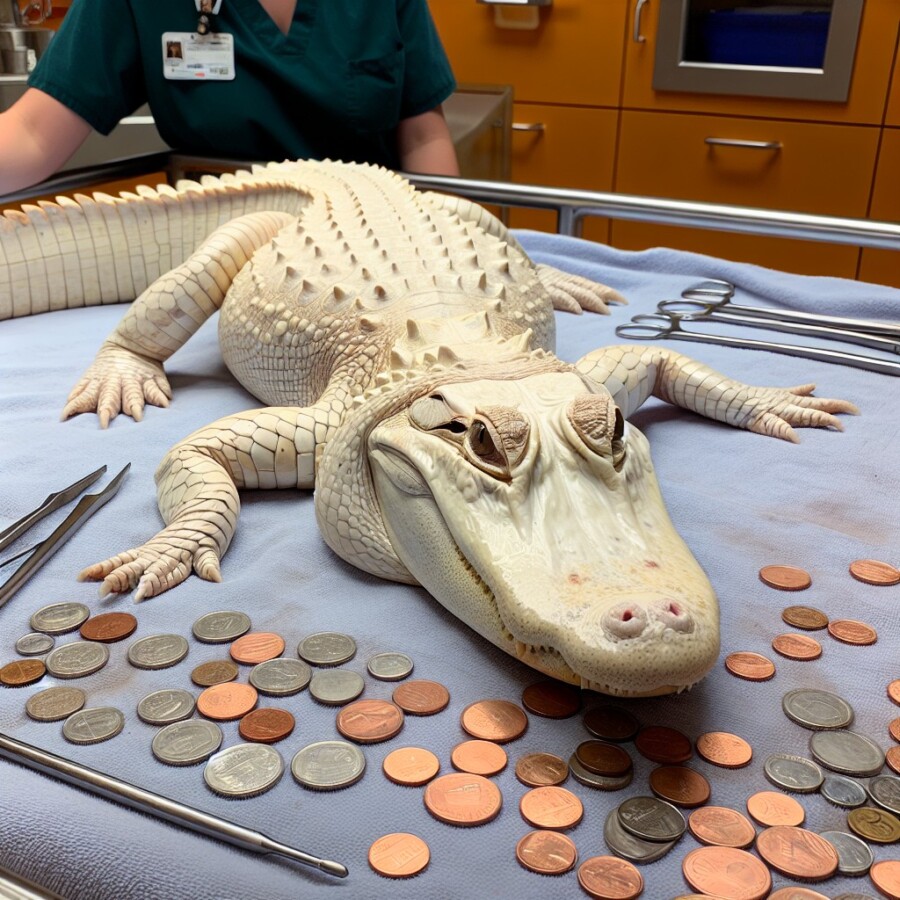A white alligator at a zoo in Nebraska had to undergo surgery to remove 70 coins from its stomach. The 36-year-old leucistic alligator, named Thibodaux, has a rare condition that gives it white skin and blue eyes. The coins were thrown into the enclosure by zoo visitors and were eaten by the alligator over time. The zoo has urged visitors to refrain from throwing coins into any bodies of water at the zoo. Thibodaux has recovered from the surgery and is back in its habitat.
The zoo conducted a routine examination of all 10 alligators, including Thibodaux, which involved blood collection and X-ray imaging. When the coins were discovered, the zoo acted quickly and performed surgery to remove them before they caused any harm to the alligator. The procedure was led by associate veterinarian Christina Ploog, who used a plastic pipe to protect the alligator’s mouth and safely retrieve the coins.
The zoo emphasized that this type of procedure is not common and highlighted the potential harm that coins can cause to animals. Ingesting coins can be dangerous for animals, as they may contain harmful chemicals. The zoo assured concerned individuals that they conduct routine cleanings in the habitats, but the alligators still manage to find and ingest the coins before they are removed.
This incident sheds light on the importance of being mindful of the objects we throw into animal enclosures. It is crucial to understand that even seemingly harmless items like coins can pose a threat to the health and well-being of animals. The zoo’s successful surgery on Thibodaux serves as a reminder to visitors to respect the animals and their habitats by refraining from throwing any objects into their enclosures.
Original news source: US zoo extracts 70 coins from white alligator (BBC)
🎧 Listen:
Slow
Normal
Fast
📖 Vocabulary:
| 1 | leucistic | Having a condition that results in reduced pigmentation |
| 2 | enclosure | A space or area that is enclosed, especially for animals |
| 3 | ingesting | The act of consuming or taking something in by swallowing or absorbing it |
| 4 | veterinarian | A professional who practices veterinary medicine by treating diseases, disorders, and injuries in animals |
| 5 | procedure | A series of actions conducted in a certain order or manner for a specific purpose |
| 6 | harmful | Likely to cause damage or injury |
| 7 | chemicals | Substances used in or produced by chemical processes |
| 8 | routine | Performed as part of a regular schedule or procedure |
| 9 | habitats | The natural environments in which a particular species lives |
| 10 | mindful | Being aware of or considering the effects of one’s actions on others |
| 11 | crucial | Of paramount importance; decisive or critical |
| 12 | seemingly | Appearing to be true or real only until examined more closely |
| 13 | threat | A source of danger or harm |
| 14 | well-being | The state of being healthy, happy, or prosperous |
| 15 | refraining | The act of deliberately not doing or using something |
Group or Classroom Activities
Warm-up Activities:
– News Summary
Instructions: Divide the class into pairs or small groups. Give each group a few minutes to read the article. Then, ask them to summarize the main points of the article in a paragraph or two. Each group can then share their summary with the rest of the class.
– Opinion Spectrum
Instructions: Create a list of statements related to the article, such as “Throwing coins into animal enclosures is unacceptable” or “Zoos should have stricter rules to prevent visitors from throwing objects into animal habitats.” Have students stand in a line and give them a scale of 1-10 (1 being strongly disagree and 10 being strongly agree). Read each statement aloud and ask students to stand at the point on the spectrum that represents their opinion. After each statement, allow a few students to explain their reasoning.
– Vocabulary Pictionary
Instructions: Choose 10 vocabulary words from the article, such as “leucistic,” “enclosure,” or “ingest.” Divide the class into teams and give each team a whiteboard or a piece of paper. Call out a vocabulary word and each team has to draw a picture that represents the word. The other teams have to guess the word based on the picture. Teams earn a point for each correct guess.
– Keyword Taboo
Instructions: Write down several keywords from the article on separate index cards, such as “alligator,” “coins,” or “surgery.” Divide the class into two teams. One member from each team comes to the front of the class and sits with their back to the board. Show the audience (the rest of the class) one of the keyword cards. The audience has to describe the keyword without using the actual word, and the team member at the front has to guess the keyword. The team that guesses the most keywords correctly wins.
– Future Predictions
Instructions: Ask students to imagine they are zookeepers at the Nebraska zoo where Thibodaux lives. In pairs or small groups, have them discuss and make predictions about what changes they would implement to prevent visitors from throwing objects into animal enclosures. They should also consider how they would educate visitors about the potential harm of such actions. After a few minutes, have each group share their ideas with the class.
🤔 Comprehension Questions:
1. What is the condition that gives Thibodaux its white skin and blue eyes?
2. How many coins were removed from Thibodaux’s stomach?
3. How did the zoo discover the coins in Thibodaux’s stomach?
4. Who led the surgery to remove the coins from Thibodaux?
5. Why is it dangerous for animals to ingest coins?
6. How does the zoo try to prevent animals from ingesting coins?
7. What is the main message the zoo wants visitors to understand?
8. What does this incident teach us about our behavior towards animals in zoos?
Go to answers ⇩
🎧✍️ Listen and Fill in the Gaps:
A white alligator at a zoo in Nebraska had to undergo surgery to remove 70 coins from its (1)______. The 36-year-old leucistic alligator, named Thibodaux, has a rare condition that gives it white skin and blue eyes. The coins were thrown into the enclosure by zoo (2)______ and were eaten by the alligator over time. The zoo has urged visitors to refrain from (3)______ coins into any (4)______ of water at the zoo. Thibodaux has recovered from the surgery and is back in its habitat.
The zoo (5)______ a routine examination of all 10 alligators, including Thibodaux, which involved (6)______ collection and X-ray imaging. When the coins were discovered, the zoo acted quickly and performed surgery to remove them before they (7)______ any harm to the alligator. The (8)______ was led by associate veterinarian Christina Ploog, who used a plastic pipe to protect the alligator’s mouth and safely retrieve the coins.
The zoo emphasized that this type of procedure is not common and (9)______ the potential harm that coins can cause to animals. Ingesting coins can be dangerous for animals, as they may contain harmful chemicals. The zoo assured concerned individuals that they conduct (10)______ cleanings in the habitats, but the (11)______ still manage to find and (12)______ the coins before they are removed.
This incident sheds (13)______ on the importance of being mindful of the objects we throw into animal enclosures. It is crucial to understand that even seemingly harmless items like coins can pose a threat to the (14)______ and well-being of (15)______. The zoo’s successful (16)______ on Thibodaux serves as a reminder to visitors to respect the animals and their habitats by refraining from throwing any objects into their enclosures.
Go to answers ⇩
💬 Discussion Questions:
Students can ask a partner these questions, or discuss them as a group.
1. What is a leucistic alligator?
2. How would you feel if you saw someone throwing coins into an animal enclosure at a zoo?
3. Do you think people should be allowed to throw coins into animal enclosures? Why or why not?
4. Have you ever witnessed someone throwing objects into an animal enclosure at a zoo? How did it make you feel?
5. What other types of objects do you think people should avoid throwing into animal enclosures?
6. Do you think the zoo should impose stricter rules and penalties for people who throw objects into animal enclosures? Why or why not?
7. Have you ever visited a zoo where visitors were allowed to feed the animals? How did you feel about this practice?
8. How do you think the alligator felt while it had the coins in its stomach?
9. Do you think the alligator’s rare condition made it more susceptible to eating the coins? Why or why not?
10. What other dangers do you think animals in zoos face due to human behavior?
11. How do you think the zoo can prevent visitors from throwing objects into animal enclosures in the future?
12. What do you think the zoo should do if they catch someone throwing objects into animal enclosures?
13. Have you ever witnessed an animal getting sick or injured due to human interaction at a zoo?
14. Do you think people should be educated about the potential harm they can cause to animals in zoos? Why or why not?
15. How do you think the zoo can raise awareness about the importance of respecting animals and their habitats?
Individual Activities
📖💭 Vocabulary Meanings:
Match each word to its meaning.
Words:
1. leucistic
2. enclosure
3. ingesting
4. veterinarian
5. procedure
6. harmful
7. chemicals
8. routine
9. habitats
10. mindful
11. crucial
12. seemingly
13. threat
14. well-being
15. refraining
Meanings:
(A) A professional who practices veterinary medicine by treating diseases, disorders, and injuries in animals
(B) Having a condition that results in reduced pigmentation
(C) A source of danger or harm
(D) The act of deliberately not doing or using something
(E) Of paramount importance; decisive or critical
(F) Substances used in or produced by chemical processes
(G) The act of consuming or taking something in by swallowing or absorbing it
(H) Likely to cause damage or injury
(I) The state of being healthy, happy, or prosperous
(J) Being aware of or considering the effects of one’s actions on others
(K) The natural environments in which a particular species lives
(L) A series of actions conducted in a certain order or manner for a specific purpose
(M) Performed as part of a regular schedule or procedure
(N) A space or area that is enclosed, especially for animals
(O) Appearing to be true or real only until examined more closely
Go to answers ⇩
🔡 Multiple Choice Questions:
1. What condition does Thibodaux, the alligator, have?
(a) Albino
(b) Melanistic
(c) Normal
(d) Leucistic
2. How old is Thibodaux?
(a) 36 years old
(b) 10 years old
(c) 50 years old
(d) 20 years old
3. What did the zoo find in Thibodaux’s stomach?
(a) Rocks
(b) Food
(c) Toys
(d) Coins
4. Who led the surgery to remove the coins from Thibodaux’s stomach?
(a) The zoo director
(b) A team of surgeons
(c) Christina Ploog
(d) Thibodaux’s trainer
5. Why did the zoo urge visitors not to throw coins into any bodies of water at the zoo?
(a) Coins can be harmful to animals
(b) Coins are expensive
(c) Coins can cause pollution
(d) Coins can damage the enclosures
6. What potential harm can coins cause to animals?
(a) They can cause physical injuries
(b) They may contain harmful chemicals
(c) They can cause infections
(d) They can cause digestive problems
7. What does the incident with Thibodaux highlight?
(a) The need for more security at the zoo
(b) The importance of respecting animals and their habitats
(c) The popularity of white alligators
(d) The dangers of throwing objects into animal enclosures
8. What is the outcome of Thibodaux’s surgery?
(a) Thibodaux needs more surgeries
(b) Thibodaux’s condition worsened after the surgery
(c) Thibodaux has recovered and is back in its habitat
(d) Thibodaux’s surgery was unsuccessful
Go to answers ⇩
🕵️ True or False Questions:
1. The zoo conducted a routine examination of all 10 alligators, including Thibodaux.
2. The alligator has a common condition that gives it white skin and blue eyes.
3. The zoo urged visitors to not throw coins into any bodies of water at the zoo.
4. The food was thrown into the alligator’s enclosure by zoo visitors.
5. The alligator has recovered from the surgery and is back in its habitat.
6. A white alligator in Nebraska had to have surgery to remove 70 rocks from its stomach.
7. The coins were discovered during the examination and the zoo quickly performed surgery to remove them.
8. The zoo emphasized the potential harm that food can cause to animals and urged visitors to be mindful of what they throw into animal enclosures.
Go to answers ⇩
📝 Write a Summary:
Write a summary of this news article in two sentences.
Check your writing now with the best free AI for English writing!
Writing Questions:
Answer the following questions. Write as much as you can for each answer.
Check your answers with our free English writing assistant!
1. What condition does the white alligator at the Nebraska zoo have?
2. How many coins were found in the alligator’s stomach?
3. How did the zoo discover the coins in the alligator’s stomach?
4. Why is it dangerous for animals to ingest coins?
5. What is the main lesson visitors should learn from this incident?
✅ Answers
🤔✅ Comprehension Question Answers:
1. What is the condition that gives Thibodaux its white skin and blue eyes?
Thibodaux has a rare condition called leucism, which gives it white skin and blue eyes.
2. How many coins were removed from Thibodaux’s stomach?
70 coins were removed from Thibodaux’s stomach.
3. How did the zoo discover the coins in Thibodaux’s stomach?
The zoo discovered the coins during a routine examination of all the alligators, which involved blood collection and X-ray imaging.
4. Who led the surgery to remove the coins from Thibodaux?
Associate veterinarian Christina Ploog led the surgery to remove the coins from Thibodaux.
5. Why is it dangerous for animals to ingest coins?
Ingesting coins can be dangerous for animals because they may contain harmful chemicals.
6. How does the zoo try to prevent animals from ingesting coins?
The zoo conducts routine cleanings in the habitats, but the alligators still manage to find and ingest the coins before they are removed.
7. What is the main message the zoo wants visitors to understand?
The main message the zoo wants visitors to understand is to refrain from throwing any objects, including coins, into animal enclosures.
8. What does this incident teach us about our behavior towards animals in zoos?
This incident teaches us that we need to be mindful of the objects we throw into animal enclosures and understand that even seemingly harmless items like coins can pose a threat to the health and well-being of animals.
Go back to questions ⇧
🎧✍️✅ Listen and Fill in the Gaps Answers:
(1) stomach
(2) visitors
(3) throwing
(4) bodies
(5) conducted
(6) blood
(7) caused
(8) procedure
(9) highlighted
(10) routine
(11) alligators
(12) ingest
(13) light
(14) health
(15) animals
(16) surgery
Go back to questions ⇧
📖💭✅ Vocabulary Meanings Answers:
1. leucistic
Answer: (B) Having a condition that results in reduced pigmentation
2. enclosure
Answer: (N) A space or area that is enclosed, especially for animals
3. ingesting
Answer: (G) The act of consuming or taking something in by swallowing or absorbing it
4. veterinarian
Answer: (A) A professional who practices veterinary medicine by treating diseases, disorders, and injuries in animals
5. procedure
Answer: (L) A series of actions conducted in a certain order or manner for a specific purpose
6. harmful
Answer: (H) Likely to cause damage or injury
7. chemicals
Answer: (F) Substances used in or produced by chemical processes
8. routine
Answer: (M) Performed as part of a regular schedule or procedure
9. habitats
Answer: (K) The natural environments in which a particular species lives
10. mindful
Answer: (J) Being aware of or considering the effects of one’s actions on others
11. crucial
Answer: (E) Of paramount importance; decisive or critical
12. seemingly
Answer: (O) Appearing to be true or real only until examined more closely
13. threat
Answer: (C) A source of danger or harm
14. well-being
Answer: (I) The state of being healthy, happy, or prosperous
15. refraining
Answer: (D) The act of deliberately not doing or using something
Go back to questions ⇧
🔡✅ Multiple Choice Answers:
1. What condition does Thibodaux, the alligator, have?
Answer: (d) Leucistic
2. How old is Thibodaux?
Answer: (a) 36 years old
3. What did the zoo find in Thibodaux’s stomach?
Answer: (d) Coins
4. Who led the surgery to remove the coins from Thibodaux’s stomach?
Answer: (c) Christina Ploog
5. Why did the zoo urge visitors not to throw coins into any bodies of water at the zoo?
Answer: (a) Coins can be harmful to animals
6. What potential harm can coins cause to animals?
Answer: (b) They may contain harmful chemicals
7. What does the incident with Thibodaux highlight?
Answer: (b) The importance of respecting animals and their habitats
8. What is the outcome of Thibodaux’s surgery?
Answer: (c) Thibodaux has recovered and is back in its habitat
Go back to questions ⇧
🕵️✅ True or False Answers:
1. The zoo conducted a routine examination of all 10 alligators, including Thibodaux. (Answer: True)
2. The alligator has a common condition that gives it white skin and blue eyes. (Answer: False)
3. The zoo urged visitors to not throw coins into any bodies of water at the zoo. (Answer: True)
4. The food was thrown into the alligator’s enclosure by zoo visitors. (Answer: False)
5. The alligator has recovered from the surgery and is back in its habitat. (Answer: True)
6. A white alligator in Nebraska had to have surgery to remove 70 rocks from its stomach. (Answer: False)
7. The coins were discovered during the examination and the zoo quickly performed surgery to remove them. (Answer: True)
8. The zoo emphasized the potential harm that food can cause to animals and urged visitors to be mindful of what they throw into animal enclosures. (Answer: False)
Go back to questions ⇧














